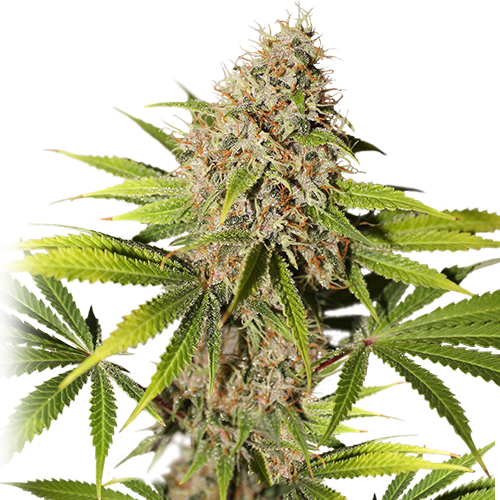Why should I buy Pineapple Poison feminised seeds?
• Pineapple Poison has a very complex and unique terpene profile, fit for any connoisseur looking for some special weed that will capture your senses
• She is a Sativa-dominant hybrid cannabis variety with a pungent aroma with mainly fruity, sweet and herbal tones. Her taste is very tropical with hints of aniseed and mint
• Pineapple Poison has an average flowering time of about 8 weeks and can be grown in a wide variety of growing conditions and climates, making her very suitable for the beginner
• It’s a robust strain that can be grown indoors as well as outdoors. She can handle both cold and hot temperatures like a champ and is known to produce a high yield, especially when grown outdoors.
Pineapple Poison has complex terpene profile, her aroma is sweet, fruity and herbal with a strong aniseed taste on the exhale
Pineapple Poison has a very special aroma. It’s kind of exotic and new, but old-school at the same time. Her mostly fruity, tropical notes are accompanied by the classic aniseed aroma of the Durban Poison. The aroma can be best described as sweet, fruity, floral and herbal with strong tones of aniseed. The taste is mainly fruity and tropical which is strongly followed by the typical aniseed flavor and some more nutty, floral tones. She will usually have a fruity pineapple taste on the inhale and the aniseed on the exhale. The buds become very frosty and compact, especially for such a Sativa dominant strain. Her complex terpene profile makes this a firm favourite amongst the cannabis connoisseurs.
Pineapple Poison is a resilient and robust cannabis variety, which can be grown both indoors and outdoors
Pineapple Poison is a strong all-rounder that is easy to grow. If you’re looking for a real Sativa experience without the fuss that sometimes comes with growing Sativa dominant strains you should give this lady a go. She is very robust and forgiving and can even be grown by new growers and beginners. Her fast flowering time ensures that every grower has the chance to make it a success, even in the more temperate climates. It’s a strain that is quite resilient to differences in temperature and humidity. Strong in surviving with low night temperatures and excelling in areas with high temperatures, this lady can literally take everything that’s thrown at her!
What kind of genetics are there in Pineapple Poison?
Pineapple Poison is a cross between a female Pineapple (Old-school Skunk selection) and a reverted Durban Poison male from Dutch Passion. The goal with this cross was to get a very strong and resilient Sativa with a new and complex terpene profile that would capture the senses. The result is a robust and vigorous Sativa that is easy to grow under a wide variety of circumstances. She can be grown both outdoor and indoor and will give a good yield especially when you train her a bit. The unique terpene profile is a perfect mix of the tropical notes of the Pineapple and the herbal aniseed profile of the Durban, it will surely leave you craving for more!
Pineapple Poison is a Sativa dominant hybrid that is very resilient and easy to grow with a quick flowering time of about 8 weeks
Pineapple Poison is a Sativa dominant cannabis strain with a strong Sativa structure, her branches are strong and super solid. It’s a vigorous plant that is very easy to grow, both outdoor and indoor. The Sativa characteristics of the Dutch Passion Durban Poison are already quite visible during the growth cycle. During early veg, the plants may look a little more Indica than you might expect. The leaves can be very big and fat, the branching and plant structure is more Sativa dominant but doesn’t have the insanely high stretch that comes with pure Sativa’s.
She is easy to grow and the buds usually have a more Sativa appearance. Indoors she can reach between 1-1,5 meters, especially if left untrained. That’s why some bending and cropping techniques are recommended to keep a more even canopy and increase yields. There is also a phenotype to be found that has smaller buds but with an impressive amount of limonene in it making it a super fruity and zesty aroma. Most of the phenotypes have a complex aroma profile that range from fruity to sweet to herbal with that particular aniseed coming from the Durban. Something that isn’t easy to be find in most of the modern crosses.
Her plant structure is medium to large, she can become pretty big if grown well but her height is still somewhat easier to control. It’s a big plant with a medium internodal distance. The nodal distance on the lower parts of the branches can be a bit larger. The main blooms of the branches often grow into thick and chunky flowers. She has a medium stretch when the lights are flipped to 12/12. The flowers start to appear from week 2-3 in bloom. She needs about 8 weeks of flowering on average but some might be a bit faster and others a bit slower. Therefore, it’s safe to say that the flowering time will be in the 7-9 weeks range.
The genetics used to create Pineapple Poison guarantee the following traits:
• A very vigorous Sativa strain with a fast-flowering time
• A resilient plant which is suitable for both outdoor and indoor growing. She has strong stems with chunky flowers and a favourable calyx-to-leaf ratio
• Pineapple Poison is easy to grow and very suitable to grow in a wide variety of growing conditions, making this an ideal strain for beginners or growers that operate in a climate or growing area that are not completely optimal
She is a strong and robust Sativa that doesn’t require a lot of experience or knowledge about nutrients. Although she doesn’t like a particularly strong feed she can still handle it quite well
Effects of Pineapple Poison
Pineapple Poison has a wonderful taste and a strong effect that will be well appreciated by connoisseurs. Its effect has a good combination of both physical as well as mental aspects. The fruity and herbal terps makes this a real joy to smoke. The high itself starts pretty euphoric and up-lifting. It’s a creative high that makes you feel energised and relaxed at the same time. It’s a great strain if you still want to be able to do stuff. Smoke a bit more and she will make you feel happy and somewhat giggly. As time passes, the initial up high transforms into a more relaxed and overall sense of well-being. The potency of the effect is of medium strength and will last for a few hours.
Pineapple Poison flowering time
Pineapple Poison is a Sativa dominant variety with a fast-flowering time of about 8 weeks on average. Some phenotypes might be even faster, these can be done in just 7 weeks. Other phenotypes, the most Sativa dominant ones might take up to 9 weeks of flowering, especially if the climate or the conditions in the grow room are far from optimal. During the last few weeks, the buds really fatten up and become more compact, so it is recommended to wait until they have ripened far enough. You can check the trichomes with a microscope to find out the right moment to harvest.
Outdoors and in greenhouses most plants will be ready at the end of September. This makes her very suitable for growing in all parts of Europe, even when the night temperatures are starting to drop significantly in September. She also does very well in polytunnels or as a guerrilla plant. There is not much that withhold her from becoming a massive cannabis plant during a few months of outdoor growing!
The yield from Pineapple Poison
Pineapple Poison has a medium sized yield of about 350-450 g/m2 on average. Being a Sativa dominant variety with a quick flowering phase of 8 weeks this is still a high yield if you compare it with other Sativa’s that might take 11-13 weeks of flowering. Her buds are very chunky and they are still pretty heavy for such a Sativa dominant appearance with foxtails.
Outdoors she can yield more than half a kg without putting in too much effort. Experienced growers can get around 1kg of dried buds when grown in the right conditions with enough sunlight hours per day. She can grow into a perfect bush, especially if you top her several times. If left un-topped, she will become fairly big and plants of more than 3-meter high are not uncommon.
Advice from our experts
Pineapple Poison is a strong and vigorous plant. If you are looking for the highest possible yield we advise topping of the main branch and possibly later on another round of topping of the new main shoots if you are having a long VEG period.
You can also use cropping and supercropping techniques to keep a more even canopy, both techniques will help to improve the yield of the strain. Regarding nutrients, she is a pretty easy feeder, and doesn’t need much expertise to grow well. We recommend keep the EC around 1.8-2 in flower for the best results (maximum of 2.2). You can also grow her completely organically for the tastiest result! As with most strains the best yield and quality indoors will come if you keep her in a stable growing environment. Between 20-29 ºC in bloom works very well and try to keep her humidity low during late flowering for the densest flowers. Don’t worry if you are not able to keep the temperatures below 30ºC, the strain has been tested several times in hot climates and was still able to produce very well. Pineapple Poison is quite homogenous, and the flowers all share that nice Sativa dominant structure and a great recognisable aroma and taste!
Information about Pineapple Poison
Overall, she is just very vigorous, and she reacts well to both topping and (super)cropping techniques. Her branches are strong and sturdy making her very suitable for both SOG and SCROG growers. She is also very resistant to (heat) stress, even in indoor grow rooms with temperatures well over 30-35º C these plants will stay stable and are able to produce some high-quality Sativa flowers. Her chunky flowers have very thin leaves in the buds and a favourable calyx-to-leaf ratio. Some phenotypes have many pistils in the flowers and some might even show some nice colourations in the buds with lilac/purple hints.






































 Fem Gem
Fem Gem 


 Energetic, Creative, Active
Energetic, Creative, Active 
